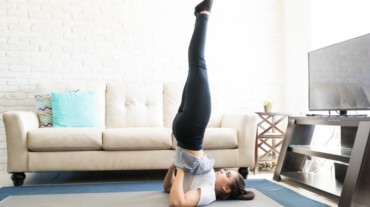Hypertension, commonly known as high blood pressure (BP), is a prevalent health issue today. It not only poses health risks by increasing the likelihood of conditions like heart disease, heart attacks, and strokes, but it can also negatively impact one’s overall well-being. Yoga is often recommended to lower high BP, and a study in BMC Public Health indicated that practicing yoga significantly enhances the odds of maintaining normal BP. However, it’s important to note that practicing yoga with hypertension carries some risks and should be approached with caution.
Is it safe to do yoga with high blood pressure?
Yoga is known for its ability to reduce stress, improve flexibility, and enhance overall well-being. However, for individuals with high blood pressure, certain yoga poses can be counterproductive and even potentially harmful. Yoga expert Himalayan Siddhaa Akshar, the founder of Akshar Yoga Research and Development Centre, says, “Certain yoga poses such as inversions, can temporarily raise BP because it increases the flow of blood towards the head, straining the neck and shoulders. Additionally, the breath control in yoga can lead to sudden BP drops, resulting in dizziness. So, people with hypertension or high BP should practice yoga under the guidance of or after consulting their doctor.”
9 yoga poses to avoid with hypertension or high blood pressure
1. Headstand (Sirsasana)
This inversion pose increases blood flow to the head and may elevate blood pressure. Individuals with hypertension should avoid putting their head below their heart for an extended period.
2. Handstand (Adho mukha vrksasana)
Similar to a headstand, a handstand is an inversion that can lead to increased blood pressure. It puts a significant demand on the cardiovascular system and may not be suitable for those with hypertension.

3. Shoulderstand (Sarvangasana)
While this pose has various health benefits, it can also raise blood pressure due to the inversion. If attempted, it should be done under the guidance of an experienced instructor and with modifications.
4. Plow pose (Halasana)
Plow pose is another inversion that can affect blood pressure. It compresses the neck and throat area, potentially leading to increased pressure. Individuals with high blood pressure should approach this pose cautiously.
Also read: Bring high BP levels under control with these 5 low sodium foods
5. Chakrasana or wheel pose (Urdhva dhanurasana)
The wheel pose is a deep backbend that can be quite intense. Hence, it may cause a spike in blood pressure. People with hypertension should approach this pose gradually and with proper modifications.
6. Intense forward bends (Paschimottanasana)
While forward bends are generally considered beneficial for relaxation, intense variations can put a strain on the cardiovascular system. It’s advisable for individuals with high blood pressure to perform these poses with caution and avoid overexertion.

7. Extended triangle pose (Utthita trikonasana)
This pose involves a wide stance and a deep stretch. For those with hypertension, it’s essential to avoid excessive strain and maintain a comfortable range of motion.
8. Warrior III (Virabhadrasana III)
This balancing pose requires stability and focus. Individuals with high blood pressure should be cautious to avoid overexertion and maintain steady breathing throughout the pose.
Also read: Tame your high BP issues with these yoga asanas and Pranayam techniques
9. Camel pose (Ustrasana)
The camel pose can be intense and may elevate blood pressure. Modifications, such as using props or reducing the depth of the backbend, can make this pose more accessible for individuals with hypertension.

Yoga poses for high blood pressure
Include these yoga poses in your daily routine to lower your high BP levels and promote overall heart health.
- Child’s Pose (Balasana): Being one of the easiest yoga poses, it promotes relaxation and stress reduction.
- Corpse Pose (Savasana): This yoga pose facilitates deep rest, calmness, and relaxation.
- Legs-Up-the-Wall Pose (Viparita Karani): Besides encouraging blood circulation in your body, it also promotes relaxation, potentially reducing the risk of heart disease.
- Standing forward bend pose (Uttanasana): It helps to calm the nervous system and improve your breathing.
- Pranayama Techniques: Pranayama techniques such as Anulom Vilom (alternate nostril breathing) and Ujjayi breathing can balance energy levels, promote relaxation, and reduce stress.
Always consult with a healthcare professional before starting any new exercise routine, including yoga, if you are a high BP patient.
#Yoga #hypertension #yoga #poses #avoid #high

